Abstract
In order to achieve the Sustainable Development Goals (SDGs), it is necessary to quantitatively examine the interactions in the EF2W nexus in more detail. The main objective of this work is to model and quantify the EF2W nexus. The approach and model (input–output model) used from the literature is applied to the case of Cameroon. This model has some advantages that make it special, namely the possibility of establishing quantitative relationships on a local, national, regional, or global scale. The results indicate that the method presented in this study is sufficiently relevant to achieve a quantitative framework for modeling the sixteen (16) relationships intertwining the EF2W. Moreover, the analyses carried out on the EF2W interactions for the three decades (1990–2020) show that the energy sector is strongly impacted by biomass, water, and petroleum products with very low impact of waste; the proportion of energy for electricity generation is, on average, 67.528%; the contribution of water (surface and groundwater, water use per ton of food) for agriculture is estimated to be 0.16%, on average, for 17.44 m3/t feed; the energy sector contributed during the three decades 0.42% for 0.88 toe/kt of energy produced. As for the waste (agricultural and animal waste), their use in the agricultural sector is, on average, 97.80%. These results have a significant impact on the energy mix in the management and distribution of production sources and its uses in the different sectors considered. A new optimal approach should be considered.
1. Introduction
The existence of water, energy, and food is important for well-being and reducing poverty for sustainable development [1,2]. However, the world’s population continues to grow at an overwhelming rate. Hoff [3], in his work, concluded that there will be a significant increase in the demand for water, energy, and food due to the pressure of population growth, economic activities, changes in diet, culture, technology, and climate. Fraiture and Wichelns [4] pointed out that the increasing demand for water for urban, industrial, and environmental protection will intensify the competition with the growing water needs for agriculture. Ferroukhi’s [5] work stated that globally, energy demand will almost double, while demand for water and food is expected to increase by more than 50% by 2050. Globalization, the expansion of urban lifestyles, and world economic growth have increased the amount of municipal waste produced in the world since the last century by a factor of 20 [6], and it now reaches two billion tons per year. Picard [6], in his work, concluded that in the energy sector in sub-Saharan Africa, despite the many riches that abound in the region, sub-Saharan populations have very little access to energy and have the lowest rates of access to electricity in the world. The rapid increase in population is outstripping the capacity of local authorities and national governments to adapt to waste management. Furthermore, Picard [6] pointed out that waste collection levels are far below their production levels and show a continual increase in the number of people without access to electricity. In addition to post-consumer food waste, huge amounts of organic waste are generated by food production processes.
Water, energy, and food security are becoming a major subject of active discussion in both developing and developed countries. Achieving certain levels of water, energy, and food security simultaneously is a complex challenge that influences other sectors, including social, political, and environmental conditions [7,8]. Research by Kenway et al. [9], Bizikova et al. [7], FAO [2], and later Gafy et al. [10] have emphasized that solving a problem partially without considering its interconnectedness will only shift problems from one resource perspective to another and may result in unintended effects. According to the Food and Agriculture Organization of the United Nations 2011, it is estimated that approximately 1.3 billion tons of the world’s food is wasted or lost, which is approximately one-third of total food production [11]. Wasting food means wasting water and energy, as food production, processing, and consumption contribute approximately 70% of the global water withdrawn and 30% of the global energy consumed [12]. Given these findings, it is essential to adopt an approach that seeks to include the interests, resources, and constraints of all actors intervening in the same domain rather than considering exclusively the concerns and responsibilities of each [13]. Figure 1 presents the water–energy–food (WEF) nexus concept.
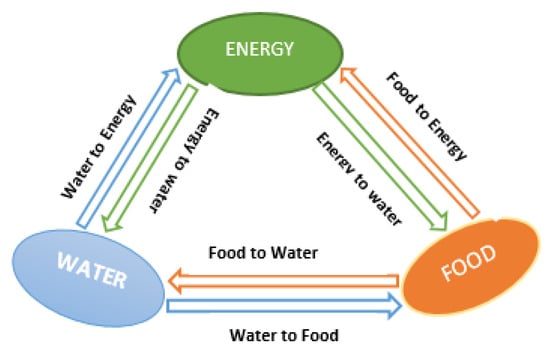
Figure 1.
Water–Energy–Food Nexus.
Many researchers sustain that the nexus is still an expanding concept [14] and is relatively immature [15], that it is narrative but not useful in applications [16], and that there are no common definitions, methods, or frameworks [17,18,19]. Because the elements that make up the traditional water–energy–food nexus are interdependent in many ways, a multi-sectoral approach is needed to harmonize the actions of policymakers on all sides: (a) agricultural policy has implications for water demand and can influence active agents in the water market; water policy has implications for agriculture, since agriculture is dependent on water resources [20]; (b) agricultural policy influences energy demand; energy policy can influence agri-food production and market prices [21]; and (c) water policy can influence energy demand; energy policy can influence water demand [22]. Much attention has been paid by researchers to the WEF concept, such as Mitchell et al. [23] and Wichelns et al. [15], who have warned that policy-making processes applying the nexus approach and involving many stakeholders, especially in developing countries, can lead to delays, slowness, and inertia. Lack of data-sharing and availability [24] and the lack of boundary definition [25] are at the root of the unsuccessful implementation of the WEF interconnections. Criticisms have been made against the expected outcome of the implementation of the nexus concept in various locations around the world. Among the criticisms are the failure to take into account the inherent political factors [26], the main democratic objective of sustainability [27], and gender aspects and the integration of programs, policies, and institutions at the national level [28], as well as the operationalization of the WEF nexus in the decision-making process [29]. Thus, there is a need for synergy of action among the elements of the nexus and integrated management of these elements and sub-elements of the concept. On the other hand, Davies et al. [30] studied the demand for water consumption for electricity generation at the global level using an integrated energy, agriculture, and climate change assessment model (the GCAM model) [31]. Similarly, Mekonnen et al. [32] assessed the global consumption water footprint (WF) of electricity and heat generation in the fuel supply, construction, and operation phases. Other researchers have applied similar targets to various regions, such as China [33] and the European Union (EU) [34]. A review article by Dodder [35] highlighted some future water demand scenarios in the energy sector. Water, energy, and food issues are intrinsically connected and interdependent. Water is needed to extract energy, to control and process raw materials, and, finally, to transform them into a usable form, such as natural gas, liquid fuels, and electricity. Globally, approximately 8% of the total water withdrawn is used for energy production, and in some developed countries, it accounts for approximately 40% of the total water withdrawn [36]. Many countries are revising their energy policies for sustainable energy production by considering a focus on carbon mitigation, cost, and security [37]. Meeting the growing water needs for rapid urbanization, increased industrial and commercial activities, agriculture, and municipalities for inclusive and uninterrupted growth in emerging countries is becoming a concern among policy makers. The energy–food–water–waste (EF2W) concept characterizes the interconnected production, allocation, and consumption processes of the four elements, as illustrated in Figure 2.
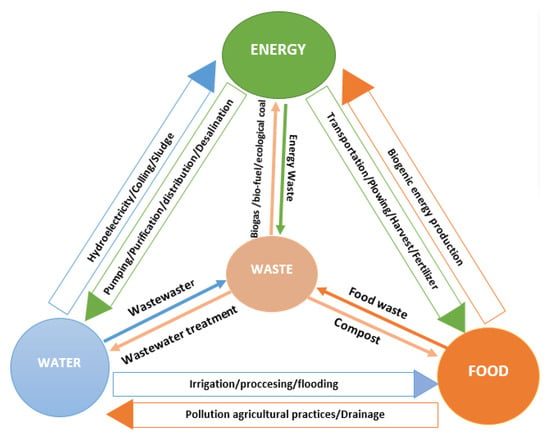
Figure 2.
Linkage of energy, food, water, and waste.
When generating, allocating, and consuming one of the elements of the energy–water–food nexus, it is impossible to avoid generating, allocating, and consuming the other two [38]. Hoff et al. [39] explained the emergence and international urgency to respond to global challenges, such as climate change, population growth, globalization, economic growth, and urbanization challenges that call for a multisectoral approach. This was the case for water, energy, food, and waste. Uneaten food turns mainly into food waste, and waste management processes further involve the production and consumption of water and energy [40]. The intrinsically intertwined relationship among the four indicates the need to use the concept of linkage as a tool, to solve the problems encountered when attempting to achieve sustainability for individual elements [41]. According to the French Environment and Energy Management Agency (ADEME), bio-waste represents 80% of the waste from the food industry, 60% of the waste from large-scale food distribution, and 55% of the waste from collective catering. Thus, a meal in collective catering generates, on average, 450 g of waste, of which 200 g are biodegradable. Wasting food means wasting water and energy, as food production, processing, and consumption contribute to approximately 70% of the global water withdrawn and 30% of the global energy consumed [12]. The SDGs adopted in September 2015 include specific targets for waste management, such as Target 11.6, which aims to “reduce the negative environmental impact of cities per capita by 2030, including with special attention to air quality and general waste management.” Considerable efforts are expected from each country to set their own national targets and monitor their progress, with methodologies established by the UN agencies. It is in this context that the main motivation for this work lies.
The objective of this work is to make a quantification from a modeling and statistical analysis of the EF2W link. The input–output model defined by Miller [42] to analyze the interactions statistically among the industries of a nation is used in this paper. This study is developed and applied to Cameroon. Three categories of waste, namely wastewater, municipal solid waste, and agricultural waste, are quantified. Several tools are used, such as the literature in the field, investigations, and stakeholder consultations, in order to develop the quantitative relationship model among the elements of the EF2W nexus. This study, in its context and approach, is the first in Cameroon. Thus, the main contributions of this study are the following:
- An analysis of energy, food, water, and waste production technologies was conducted to identify the degree of consumption of the different relationship elements for production.
- The (16) sixteen different EF2W nexus elements were established, and their quantifications were obtained. A temporal quantitative evolution of the interconnection was possible for forecasting and optimization of the nexus elements.
- The cross-sectoral effects on energy, food, water, and waste production were obtained and quantified.
This paper consists of five sections, namely the introduction in the first section, followed by the second section, which describes the proposed approach in which the preliminary theoretical model, the applied methodology, the EF2W indicators, the dynamic model, as well as the process steps and the definition of the variables are detailed. Then, the third section consists of the presentation of the data, followed by the fourth section devoted to the interpretation of the results and discussions. Finally, the conclusion is presented in the fifth section.
2. Proposed Approach
2.1. Preliminary Theoretical Model
The approach proposed in this work is the one developed by Karnib [43] to quantify and determine the relationship in the water–energy–food nexus. Adopting this approach, the quantitative equilibrium equation is given by Relation (1):
The vector of final demand quantities (D) is the one used in the socio-economic system and covers household demands, government demands, demands from the rest of the economy, losses, accumulation (storage), and exports. The matrix of intersectoral use quantities (K), and the vector of total resource quantities (P) are connected by a matrix of intersectoral intensity coefficients (C). Figure 3 shows the preliminary conceptual model of the proposed energy, food, water, and waste (EF2W) nexus and the driver and stakeholder changes.
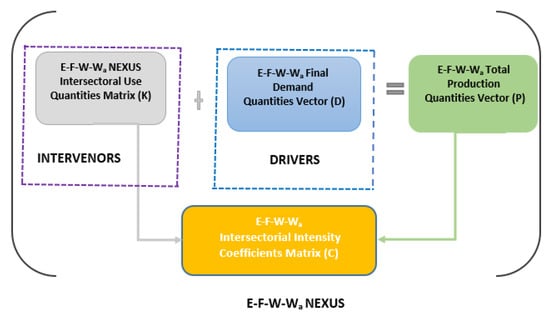
Figure 3.
The preliminary conceptual model of the energy, food, water, and waste nexus.
2.2. Applied Methodology
In order to complete the quantitative resource balance, the proposed E-F-W-Wa nexus method is established, as shown in Table 1, with the sixteen intersectoral relationships among energy, food, water, and waste.

Table 1.
The EF2W nexus elements.
The consumption of the ith resource in the jth resource is governed by the intersectoral relationships e_e, e_f, e_w, e_𝑤, f_e, f_f, f_w, f_𝑤𝑎, w_e, w_f, w_w, w_𝑤𝑎, 𝑤𝑎_e, 𝑤𝑎_f, 𝑤𝑎_w, and 𝑤𝑎_𝑤𝑎, where e, f, w, and 𝑤𝑎 stand for energy, food, water, and waste, respectively, D is the final production demand, and P is the total production quantity.
The following terms m, n, h, and r are the number of resources, respectively, in energy (oil, natural gas, electricity, renewable energy, etc.), in food (irrigated crops, animal production, fishing, hunting, etc.), in water (surface water, groundwater, desalination, etc.), and in waste (agricultural waste, livestock waste, household waste, etc.). The equations of the energy–food–water–waste balance are:
where , , , and are the i th energy, food, water, and waste resources, respectively.
The coefficients of linkage intensity in the FE2W link are also governed by the elements of the intersectoral link: . Equations (2)–(5) become:
with C being the technological matrix of the E-F-W-Wa nexus given by Equation (7):
Finally, we have
with
Expression (6) represents the inverse Leontief matrix, and is the Identity matrix [42]. The details of the different steps are provided in the Supplementary Materials.
2.3. The Link Indicators E-F-W-Wa
In this section we present the EF2W indicators calculated on the basis of the model presented in Section 2.2.
Energy indicator in the nexus:
- Energy consumption in the jth production of energy, food, water, and waste resources are, respectively, given by:
- 2.
- Energy consumption related to energy, food, water, and waste are, respectively, given by:
- 3.
- Energy consumption intensity related to energy, food, water, and waste:
- 4.
- Proportion of energy consumption related to energy, food, water, and waste in relation to total energy consumption is expressed in %.
Food indicator in the nexus
- 5.
- Food consumption in the jth production of energy, food, water, and waste resources is given by:
- 6.
- Food consumption related to energy, food, water, and waste:
- 7.
- Food consumption intensity related to energy, food, water, and waste:
- 8.
- Proportion of food consumption related to energy, food, water, and waste in relation to total food consumption is expressed in %.
Water indicator in the nexus
- 9.
- Water consumption in the production of energy, food, water, and waste resources:
- 10.
- Water consumption related to energy, food, water, and waste:
- 11.
- Water consumption intensity related to energy, food, water, and waste:
- 12.
- Proportion of water consumption related to energy, food, water, and waste in relation to total water consumption is expressed in %.
Waste indicator in the nexus
- 13.
- Consumption of waste in the jth production of energy, food, water, and waste resources are given respectively by:
- 14.
- Waste consumption related to energy, food, water, and waste:
- 15.
- Waste consumption intensity related to energy, food, water, and waste:
- 16.
- Proportion of waste consumption related to energy, food, water, and waste in relation to total waste consumption is expressed in %.
2.4. Dynamic Model
Suppose there is a change in final demand . In the absence of technological changes, the technical coefficients of the matrix C are constant, so to reformulate this system of linear equations in matrix form, we define the matrix according to Aleskerov [44]:
where from Equation (14) becomes: , and the nexus technology matrix E-F-W-Wa is . This technological matrix is unchanged, and L, which is the inverse of Leontief, also remains unchanged. Thus, the output necessary to satisfy this new demand is: and , where and denotes the new value of total resource quantities and the matrix of intersectoral use quantities, respectively. Let us call by total production in the static model (initial year), final demand in the initial year, and the initial intersectoral utilization quantity. Variations can be assessed as follows: , ;
2.5. Steps in the Analysis Process
The process consists first of all in identifying the energy, food, water, and waste production technologies that use the elements of the EF2W for its activities. Then, the energy, food, water, and waste use coefficients for all selected technologies are assessed in order to develop possible institutional arrangements, including public intervention, that can support the adoption of nexus approaches where they can improve the sustainability and resource security of each component system. By finally integrating the potential impacts on other systems into the decision-making, we can develop effective solutions in all the sectors considered.
3. Data Presentation
Within the framework of this work, Ei is the whole of energy resources, Fi the whole of food resources, Wi the whole of water resources, and Wai the whole of waste. The individual components are as follows: E1 oil, E2 natural gas, E3 hydroelectricity, E4 source of solar photovoltaic/wind energy, E5 energy resulting from the biomass, E6 geothermal energy, E7 gas oil, E8 fuel oil, E9 gasoline, E10 electricity, and E11 coal; F1 potato, F2 wheat, F3 dry beans, F4 soybeans, F5 rice, F6 maize, F7 millet, F8 sorghum, F9 donkeys, F10 cattle, F11 cattle, dairy cows; F12 goats, F13 horses, F14 sheep, F15 meat chickens; F16 laying chickens, F17 market animals, and F18 breeding animals; W1 surface water, W2 groundwater, W3 wastewater reuse, and W4 recycled water reuse and agricultural drainage water.
The data in the energy demand and production sector are those of the International Energy Agency database for the years 1990, 2000, 2010, 2015, and 2019 [45]. We chose to quantitatively assess the EF2W nexus over at least three decades in order to observe the quantitative evolution of the nexus elements. Regarding the data on agriculture (production, production demand, irrigated area, agricultural waste, energy use in the agricultural sector, and manure applied to soils), the data are those of the FAO-AQUASTAT database [46] and AQUASTAT [47]. The GDP data are from the World Bank database (DataBank Microdonnées 2023).
4. Results and Discussion
Table 2 presents the different elements of the energy, food, water, and waste nexus, with the elements of the EF2W nexus consumed as inputs and the elements of the EF2W nexus produced as outputs, which allows for better planning of the management of the different resources. The agricultural and livestock sectors use three of the four nexus elements, namely energy, water, and waste for agriculture; energy, water, and food for livestock; and both produce food and waste. Hydroelectric and thermal power plants consume energy and water to produce energy. On the other hand, solar, wind, and traditional wells do not need any of the nexus elements for the operation and produce energy (solar and wind) and water (traditional wells), respectively. The use of biogas in agriculture or livestock as an energy source generates a double consumption of water (agricultural/livestock water and water for biogas production) and waste (waste brought to the soil as fertilizer and waste for energy production) for a food and waste production. Thus, the use of solar photovoltaic/wind turbine in energy using technologies can reduce the input of other of the nexus elements. This rationalizes the flow and optimizes the consumption of the nexus elements. It is, therefore, necessary to quantitatively determine the degree of the relationships among energy, water, food, and waste in order to sustain the resources.

Table 2.
Elements consumed in input and elements produced in output of the EF2W nexus technologies.
- Energy indicator in the nexus
- Energy for energy (e_e):
Cameroon’s energy balance shows a clear dominance of renewable energy, and as shown in Figure 4a–e, there has been a marked dependence on biomass in the country’s energy supply for several decades. These observations are very close to those in Godom [48] and Ngnikam [49]. Modern energy production in Cameroon is characterized by the dominance of electrical energy. This electrical energy is produced from two main sources: oil and hydroelectricity.
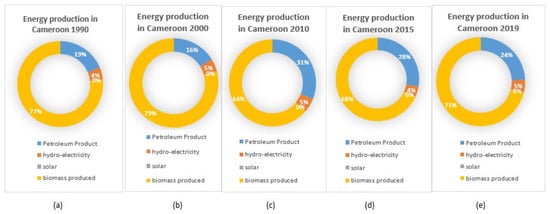
Figure 4.
Energy produced by sector in Cameroon for the energy sector.
As shown in Figure 5, the production of electrical energy is more renewable than fossil fuel, during which time we see an exponential growth in the coefficients and of fossil fuel use in the electrical energy production system in Cameroon from 2000 to 2015 and a downward trend from 2015 to 2019 (Table 3). The increase in the share of fossil fuels in Cameroon’s energy mix can be explained by the initiation of the Emergency Thermal Program (ETP) in 2009, which resulted in the commissioning of several thermal power plants. This Emergency Thermal Program is due to the increase in demand for electricity due to demographic growth, the development of income-generating activities, the change in energy use habits, and the development of the industrial sector. The decline in power plant output from 2015 is linked to the oil crisis of 2015, and its impacts were felt approximately 4 years later. Hence, the increase in production via renewable energy sources.
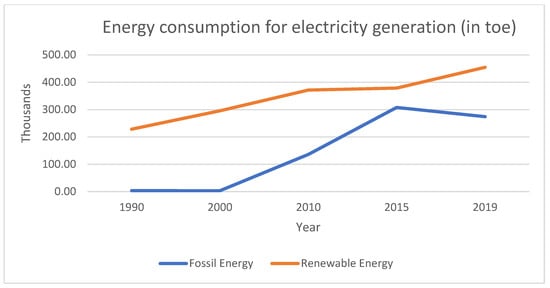
Figure 5.
Energy consumption for electricity production.

Table 3.
Energy consumption for the production of electrical energy (in toe).
The coefficients of energy consumption in Cameroon for the total amount of energy produced (Table 4) are on the rise globally from 1990 to 2010, explained by the increase in the share of energy consumed in the electricity sector and a downward trend from 2015 to 2019, which is due to an increase in total energy production consumed in other sectors.

Table 4.
Energy use link coefficients for energy.
In Table 5, it can be seen that the quantities of hydro, biomass, and waste energy produced are totally consumed by the electricity sector. On the other hand, natural gas consumption fell to 29.62 percent of total consumption for power generation between 2010 and 2015. This low consumption of natural gas for energy production in Cameroon can be explained by the fact that it will be exported in 2018. It is important to note that the production of natural gas increased by 35.29% between 2010 and 2015 and 79.01% between 2015 and 2019, but its consumption for energy production is 29.63% in 2019, 2020, and 34% in 2021 according to the SNH (National Hydrocarbons Company, Yaounde, Cameroon). Indeed, the share of petroleum products in the production of electricity is not without effect on the price hike observed, which is 37.6% (12.0% oil and 25.6% natural gas) in the production of electricity. On the other hand, the country is full of very good solar and wind potential, which in the case of this work, is shown to be favorable in the nexus studied and can contribute to a reduction in the use of petroleum products in electricity production. Nevertheless, the intermittent nature of these energy sources could be a handicap to fully meeting the demand. Therefore, a combination, such as back-up energy systems, would be an asset to mitigate the negative effects of fluctuations and stabilize electricity production.

Table 5.
Energy consumption intensity in the production of electrical energy in Cameroon.
- Energy use in the agricultural sectors: energy for agriculture
Table 6 shows the different total values of agricultural production from 1990 to 2019 in 5-year steps. The overall observation of food production has an increasing trend, which is in agreement with the conclusions of Godom [48]. This is because agriculture is a key sector of the Cameroonian economy, ensuring food self-sufficiency and foreign exchange. Although agricultural production has remained on the rise, the share of agriculture, which represented 33.64% of GDP in 1977, is declining to 20.59% in 1985, 17.49% in 2020, and 16.91% in 2021. This could be attributed to the increase in investment and good technical supervision in this sector, which are also boosted by the increase in internal and external demand. In addition, local labor is available and at a lower cost. This would increase the energy input in the production chain. Maintaining or increasing the level of energy consumption would be an asset for productivity if and only if demand increases with demographic growth.

Table 6.
Total agricultural production in (kt).
Diesel, gasoline, liquefied natural gas, fuel oil, coal, and electricity are the energy types used in the agricultural sector (in toe) (Table 7).

Table 7.
Energy consumption in agriculture.
At Figure 6 it can be seen that the use of coal in the agricultural sector is very low globally. However, fuel oil has been declining overall during the three decades. It dropped from 63% in 1990 to 28% in 2000 and then to 19% and 16% in 2015 and 2020, respectively. There is an increasing use of diesel, electricity, and motor gasoline in the agricultural sector, except in 2010 when both electricity and motor gasoline decreased. Agricultural production is growing in its entirety, while a diversified use of energy products is observed in varying proportions, leading to a less mechanized agriculture.
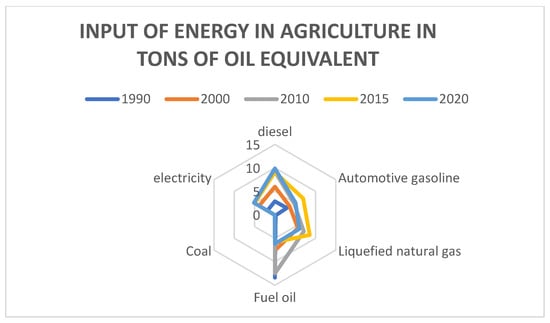
Figure 6.
Energy consumption by agriculture (in millions toe).
The various energy sources used in the agricultural sector (Table 8) show an overall upward trend, but the coefficients for the energy–food nexus (Table 9) show a downward trend. This can be explained by the fact that the country’s agricultural system is based on subsistence farming using traditional techniques, and given its low level of mechanization, an increase in production and a low energy nexus are observed. Mechanization of the agricultural sector—given the estimated 7.2 million hectares of arable land, of which only 1.8 million hectares are actually cultivated—would be a major asset to the development of the agricultural sector and would considerably reduce the country’s food imports. However, mechanization would increase the need for energy. It would be necessary to find a mechanism to manage the distribution and consumption of energy according to the sectors of activity so that the supply is proportional to the demand.

Table 8.
Technology coefficients of the energy and power nexus (in toe/kt).

Table 9.
Proportion of energy related to total energy consumption (in %).
- Water production by the energy sector: Energy to Water (e_w)
In the cases of this study, this relationship was not established due to the unavailability of quantitative data during the investigations.
- The production of solid waste by the energy sector: Energy to Waste (e_wa)
According to Boulday and Marcovecchio [50], a biomass boiler room produces ash (between 0.5 and 10% of the incoming wood). For many African countries, biomass often represents close to 90% of the overall energy balance. In the case of this study, the determination of the amount of waste (biomass ash) is calculated by assuming that the combustion of biomass produces between 0.5 and 10% of the incoming wood. The minimum quantity was evaluated on the basis of the minimum value of 0.5% of the incoming wood and the maximum of 10%, and the average value of ash produced is estimated to be 5.25%
The values considered in the remainder of this work are the average values of ash produced by the biomass (Figure 7). In addition to the ash produced and recovered by the biomass, there are gases and dust released into the atmosphere. According to Kenne [51], Cameroon generates approximately 70,000 tons of waste oil per year from trucks, buses, cars, etc. For the purposes of this study, the constant value of 70,000 tons will be considered as the quantity of waste produced by the oil sector.
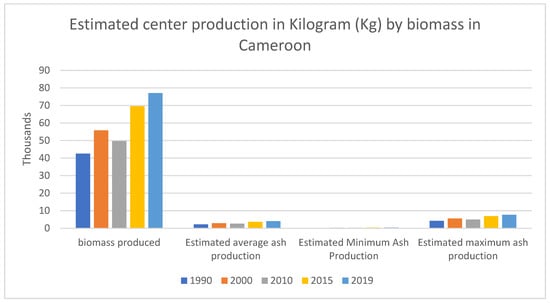
Figure 7.
Estimated ash production in kilograms from biomass in Cameroon.
The overall observation of solid waste generation technology coefficients by the energy sector has a decreasing trend from 0.0014 t/toe in 1990 to 0.00071 t/toe in 2019 (Table 10). This decrease can be explained by an improvement in the mastery of production technology (optimization, efficiency, and use of advanced technology equipment).

Table 10.
Waste-to-energy technology coefficients (kg/toe).
- Energy production by the food sector: Food_energy (f_e)
This link is not established in the case of this work because the country does not yet practice the cultivation of energy plants for biofuel production.
- Water production by food: Food to Water (f_w)
The water production by the food sector in the case in this paper is considered to be very low.
Waste generation by agriculture: Food_Waste (f_wa)
Table 11 presents the agricultural production in tons of food for which quantitative data on waste generation are available.

Table 11.
Agricultural production (in t).
Like production, agricultural waste as a whole is increasing (Table 12). Overall, an increase in waste generated by the agricultural sector is observed, from 0.24 kg/t to 0.46 kg/t (Table 13). It should also be noted that a slight decrease in waste produced by the agricultural sector between 1995 and 2000, from 0.36 kg/t to 0.30 kg/t according to Table 13, can be justified by a decrease in millet and sorghum production.

Table 12.
Waste generation by the agricultural sector (in t).

Table 13.
Technology coefficient of waste production by agriculture (in kg/t).
Figure 8 shows the different types of animals and the amount of waste produced by them (in kg). It can be seen that market swine produce more waste than all the waste produced by other animals.
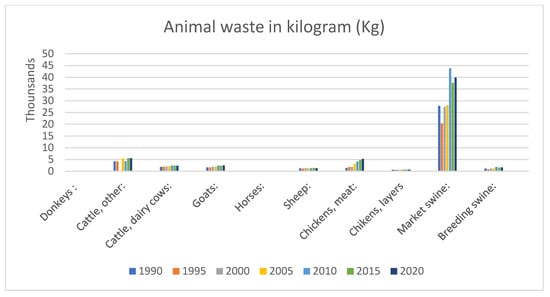
Figure 8.
Animal waste in kilogram (kg).
Table 14 presents the technology coefficients of waste production by the livestock sector, which has a decreasing trend overall.

Table 14.
Coefficient of waste linkage produced by the livestock sector (kg/t).
Investigations among farmers have shown that urbanization and economic development generally result in increased per capita waste production and increased food needs. In Cameroon, farmers use a variety of fertilization methods. In addition to mineral fertilizers, two main types of organic wastes are used in urban and peri-urban agriculture: organic wastes of animal origin (poultry droppings and manures) and organic amendments of plant origin (household waste composts). It is important to note that in urban and peri-urban areas, solid waste management is limited to collection, transportation, and dumping. On the other hand, in rural areas, household waste (food waste) produced on a small scale is used as fertilizer in the agricultural sector. The absence of solid waste sorting (pre-collection of waste) did not allow for quantitative determination of the food waste produced by households. Table 15 presents a varying rate of waste generation by the agricultural sector. An increase is observed from the years 1990 to 1995 and from 2000 to 2010, followed by a decrease in waste production from 1995 to 2005 and from 2010 to 2020.

Table 15.
Proportion of waste generation by agriculture (in %).
- Energy production by water: Water to Energy (w_e)
In this study, quantitative data on water use in the energy sector are unavailable for most water-consuming energy production sectors.
- Agricultural production by the water sector: Water to Food (w_f)
There is a constant need for irrigation water and a constant production of groundwater and surface water during the three decades (Table 16).

Table 16.
Distribution of water resources and water demand by agriculture, in billion cubic meters (Mm3).
Groundwater withdrawal increased from 0.14 Mm3 of water in 1990 to 0.36 Mm3 of water and remained constant from 2000 to 2019 at 0.74 Mm3 (Table 17).

Table 17.
Water use by irrigated agriculture (in Mm3).
With regard to the technical coefficients in Table 18, an increase in water consumption by agriculture in 1990, 1995, and 2000 of 7.67 m3/t, 16.70 m3/t, and 30.51 m3/t, respectively, can be observed. However, an overall decrease in the quantity of water used for agriculture between 2000 and 2019 is observed from 30.50 m3/t to 23.14 m3/t in 2005 and then to 13.36 m3/t in 2019. It is important to note that this study does not take into account rainwater.

Table 18.
Technical coefficients of the water supply link (in m3/t).
Agricultural production is highly dependent on water and is increasingly exposed to water-related risks. It is also the largest consumer of water and one of the largest polluters of this resource. Table 19 shows a low proportion of water use by irrigated agriculture in relation to total agricultural water but a strong water–food link (Table 18). With regard to the country’s agricultural production, it can be seen that agriculture in Cameroon is rain-fed, with a low rate of groundwater abstraction for agricultural use. However, the irrigable potential is estimated at 240,000 hectares, but less than 33,000 hectares are currently irrigated. Indeed, quantitative control of water flows (surface and underground) would make it possible to secure food production by limiting its inter-annual variations and to increase it through an increase in surface area, intensification, and diversification.

Table 19.
Proportion of agricultural water use in the total water resource.
- Waste generation by the water sector: Water to Waste (w_)
Municipal and domestic wastewater, contaminated water, and oil water constitute the water waste. The unavailability of wastewater data did not allow the nexus of water to waste.
- Energy production from waste: Waste to Energy (wa_e)
Due to the unavailability of a database and the lack of large-scale recovery of food waste, the waste–energy link is not established.
- Food production from waste: Waste to Food (wa_f)
The waste produced by animals is applied in the agricultural sector as manure, while some of the agricultural residues are burned and some are reused in agriculture. In rural areas, waste from biomass combustion is also used in agriculture as fertilizer. Figure 9 provides an overview of the residues produced, burned, and used in agriculture.

Figure 9.
Production and consumption of waste by agriculture.
As shown in Figure 9, the waste produced by the food sector (agriculture and livestock) is, on average, 97.81% reused in agriculture as fertilizer and 2.19% burned during the last three decades.
In Table 20, from 1990 to 1995 and from 2000 to 2010, an upward trend is observed from 0.68 kg/t to 0.93 kg/t and a downward trend from 1995 to 2000 and from 2010 to 2020.

Table 20.
Technical coefficients of the waste–food nexus (kg/kg).
In Table 21, the proportion of waste used in agriculture as a whole has a slightly increasing trend from 1995 to 2000 and then from 2015 to 2020, and a slight decrease is observed from 1990 to 1995 and then from 2000 to 2015.

Table 21.
Proportion of waste use by agriculture (in %).
- Water production from waste: Waste to Water (wa_w)
This refers to wastewater (municipal wastewater, drainage wastewater, contaminated water, and hydrocarbon water) that is captured, purified, and reused or water extracted from solid waste and used. This practice is not widely used in Cameroon, hence the unavailability of data.
- Waste generation by the water sector: Waste to Waste (wa_wa)
This relationship is considered very weak and, therefore, not established in this work.
5. Conclusions
A modeling approach and a systematic analysis of the EF2W linkage study was conducted in the Cameroonian context on the basis of investigations, stakeholder consultations, and the use of applied approaches and models in the literature. These analyses and relying on approaches and models applied in the literature have led to several results, and the main ones are as follows:
- The consumption of one element of the link has a direct impact on at least one of the other three elements;
- The energy sector is governed by biomass (dominant element in the production of energy), hydraulic, oil, gas, and solar (very low use), which is dominated by the production of electricity, whose proportions are 45.38% in 1990, 83.01% in 2010, and 74.99% in 2019;
- The food sector has a strong link with water and a low proportion of water (ground and surface) in agriculture, estimated at an average of 0.16% over the three decades. However, production is still increasing due to the abundance of rainfed crops;
- A low energy use in agriculture is observed, with an average proportion of approximately 0.42% over the three decades because the agricultural sector has a low mechanization;
- The water sector consists of groundwater and surface water playing a very important role in the energy sector;
- Agriculture and livestock produce waste, of which an average proportion of 97.80% is used in agriculture as fertilizers during the three decades. Energy waste represents approximately 70,000 tons of used oil per year;
- A non-valorization of waste for energy production has been noted.
Synergy of action in the coordinating institutions of the energy, water, food, and waste sector is strongly recommended. To create a database on a decentralized scale to facilitate the evaluation and to allow a better planning of each element involved in the EF2W, an increase in the share of solar in the energy mix, gradually substituting petroleum products in the production of electricity is necessary and beneficial. This will lead to a decrease in the demand for oil products. The energy supply will be above the demand and will induce a decrease in the oil prices. A study of the economic and environmental impact in the EF2W nexus is envisaged in our future work. An analysis at the decentralized level could be carried out in order to identify local or regional specificities and contributions to the national production.
Supplementary Materials
The following supporting information can be downloaded at: https://www.mdpi.com/article/10.3390/su15118483/s1.
Author Contributions
Conceptualization, B.A.P.P.; Methodology, B.A.P.P. and J.C.S.; Software, B.A.P.P.; Validation, B.A.P.P., D.N. and R.T.; Formal analysis, J.C.S., D.R.K.L. and M.H.B.; Investigation, B.A.P.P., D.R.K.L. and M.H.B.; Resources, B.A.P.P., J.C.S., D.R.K.L. and M.H.B.; Data curation, B.A.P.P. and J.C.S.; Writing—original draft, B.A.P.P. and V.S.C.-D.; Writing—review & editing, B.A.P.P. and V.S.C.-D.; Visualization, D.N., R.T. and V.S.C.-D.; Supervision, D.N. and R.T. All authors have read and agreed to the published version of the manuscript.
Funding
This research received no external funding.
Data Availability Statement
The data used in this study came from the sources mentioned in Section 3 of the manuscript.
Acknowledgments
The authors would like to thank the Ministry of Water and Energy and the farmers and herders for their cooperation during the investigation periods.
Conflicts of Interest
The authors declare no conflict of interest.
Abbreviations
| kg | Kilogram |
| SNH | National Hydrocarbons Company |
| Mm3 | Billion cubic meters |
| toe | Ton of oil equivalent |
| WF | Water and Food |
| ADEME | Environment and Energy Management Agency |
| GDP | Gross Domestic Product |
| EF2W | Energy, Food, Water, and Waste |
| FAO | Food and Agriculture Organization |
| t | Ton |
| m3 | Cubic meter WEF |
| EU | European Union |
| SDG | Sustainable Development Goals |
References
- Petrariu, R.; Constantin, M.; Dinu, M.; Pătărlăgeanu, S.R.; Deaconu, M.E. Water, energy, food, waste nexus: Between synergy and trade-offs in Romania based on entrepreneurship and economic performance. Energies 2021, 14, 5172. [Google Scholar] [CrossRef]
- FAO. The Water-Energy-Food Nexus: A New Approach in Support of Food Security and Sustainable Agriculture; The Food and Agricultural Organisation of the United Nations: Rome, Italy, 2014. [Google Scholar]
- Hoff, H. Understanding the Nexus. 2011. Available online: https://policycommons.net/artifacts/1359033/understanding-the-nexus/1972269/ (accessed on 15 December 2022).
- De Fraiture, C.; Wichelns, D. Satisfying future water demands for agriculture. Agric. Water Manag. 2010, 97, 502–511. [Google Scholar] [CrossRef]
- Ferroukhi, R.; Nagpal, D.; Lopez-Peña, A.; Hodges, T.; Mohtar, R.H.; Daher, B.; Mohtar, S.; Keulertz, M. Renewable Energy in the Water, Energy and Food Nexus; International Renewable Energy Agency: Abu Dhabi, United Arab Emirates, 2015. [Google Scholar]
- Picard, S. Fêter les Classiques. Permanence et Polyfonctionnalité des Figures de Beethoven, Goethe et Hugo (1927–1970). Ph.D. Thesis, Sorbonne Université, Paris, France, 2019. [Google Scholar]
- Bizikova, L.; Roy, D.; Swanson, D.; Venema, H.D.; McCandless, M. The Water-Energy-Food Security Nexus: Towards a Practical Planning and Decision-Support Framework for Landscape Investment and Risk Management; International Institute for Sustainable Development: Winnipeg, MB, Canada, 2013; pp. 16–20. [Google Scholar]
- Endo, A.; Tsurita, I.; Burnett, K.; Orencio, P.M. A review of the current state of research on the water, energy, and food nexus. J. Hydrol. Reg. Stud. 2017, 11, 20–30. [Google Scholar] [CrossRef]
- Kenway, S.J.; Lant, P.A.; Priestley, A.; Daniels, P. The connection between water and energy in cities: A review. Water Sci. Technol. 2011, 63, 1983–1990. [Google Scholar] [CrossRef] [PubMed]
- El Gafy, I.; Grigg, N.; Reagan, W. Dynamic behaviour of the water–food–energy Nexus: Focus on crop production and consumption. Irrig. Drain. 2017, 66, 19–33. [Google Scholar] [CrossRef]
- Turral, H.; Burke, J.; Faurès, J.M. Climate Change, Water and Food Security (No. 36); Food and Agriculture Organization of the United Nations (FAO): Rome, Italy, 2011. [Google Scholar]
- Garcia, D.J.; You, F. The water-energy-food nexus and process systems engineering: A new focus. Comput. Chem. Eng. 2016, 91, 49–67. [Google Scholar] [CrossRef]
- Purwanto, A.; Sušnik, J.; Suryadi, F.X.; de Fraiture, C. Water-energy-food nexus: Critical review, practical applications, and prospects for future research. Sustainability 2021, 13, 1919. [Google Scholar] [CrossRef]
- Smajgl, A.; Ward, J.; Pluschke, L. The water–food–energy Nexus–Realising a new paradigm. J. Hydrol. 2016, 533, 533–540. [Google Scholar] [CrossRef]
- Wichelns, D. The water-energy-food nexus: Is the increasing attention warranted, from either a research or policy perspective? Environ. Sci. Policy 2017, 69, 113–123. [Google Scholar] [CrossRef]
- Middleton, C.; Allouche, J.; Gyawali, D.; Allen, S. The Rise and Implications of the Water-Energy-Food Nexus in Southeast Asia through an Environmental Justice Lens. Water Altern. 2015, 8, 627–654. [Google Scholar]
- Allouche, J.; Middleton, C.; Gyawali, D. Nexus Nirvana or Nexus Nullity? A Dynamic Approach to Security and Sustainability in the Water-Energy-Food Nexus; STEPS Working Paper 63; STEPS Centre: Brighton, UK, 2014. [Google Scholar]
- Endo, A.; Burnett, K.; Orencio, P.M.; Kumazawa, T.; Wada, C.A.; Ishii, A.; Tsurita, I.; Taniguchi, M. Methods of the water-energy-food nexus. Water 2015, 7, 5806–5830. [Google Scholar] [CrossRef]
- Albrecht, T.R.; Crootof, A.; Scott, C.A. The Water-Energy-Food Nexus: A systematic review of methods for nexus assessment. Environ. Res. Lett. 2018, 13, 043002. [Google Scholar] [CrossRef]
- Bryan, B.A.; Crossman, N.D.; Nolan, M.; Li, J.; Navarro, J.; Connor, J.D. Land use efficiency: Anticipating future demand for land-sector greenhouse gas emissions abatement and managing trade-offs with agriculture, water, and biodiversity. Glob. Chang. Biol. 2015, 21, 4098–4114. [Google Scholar] [CrossRef]
- Hafeez, M.; Yuan, C.; Shah, W.U.H.; Mahmood, M.T.; Li, X.; Iqbal, K. Evaluating the relationship among agriculture, energy demand, finance and environmental degradation in one belt and one road economies. Carbon Manag. 2020, 11, 139–154. [Google Scholar] [CrossRef]
- Hadian, S.; Madani, K. The water demand of energy: Implications for sustainable energy policy development. Sustainability 2013, 5, 4674–4687. [Google Scholar] [CrossRef]
- Mitchell, B.; Bellette, K.; Richardson, S. ‘Integrated’ approaches to water and natural resources management in South Australia. Int. J. Water Resour. Dev. 2015, 31, 718–731. [Google Scholar] [CrossRef]
- Mabrey, D.; Vittorio, M. Moving from theory to practice in the water–energy–food nexus: An evaluation of existing models and frameworks. Water-Energy Nexus 2018, 1, 17–25. [Google Scholar] [CrossRef]
- Galaitsi, S.; Veysey, J.; Huber-Lee, A. Where Is the Added Value? A Review of the Water-Energy-Food Nexus Literature; SEI: Stockholm, Sweden, 2018. [Google Scholar]
- De Grenade, R.; House-Peters, L.; Scott, C.A.; Thapa, B.; Mills-Novoa, M.; Gerlak, A.; Verbist, K. The nexus: Reconsidering environmental security and adaptive capacity. Curr. Opin. Environ. Sustain. 2016, 21, 15–21. [Google Scholar] [CrossRef]
- Biggs, E.M.; Bruce, E.; Boruff, B.; Duncan, J.M.; Horsley, J.; Pauli, N.; McNeill, K.; Neef, A.; Van Ogtrop, F.; Curnow, J.; et al. Sustainable development and the water–energy–food nexus: A perspective on livelihoods. Environ. Sci. Policy 2015, 54, 389–397. [Google Scholar] [CrossRef]
- FAO. Accelerating SDG 7 Achievement. Policy Brief 09. Water-Energy-Food Nexus for the Review of SDG 7. 2018. Available online: https://sustainabledevelopment.un.org/ (accessed on 17 January 2023).
- Simpson, G.B.; Jewitt, G.P. The water-energy-food nexus in the anthropocene: Moving from ‘nexus thinking’ to ‘nexus action’. Curr. Opin. Environ. Sustain. 2019, 40, 117–123. [Google Scholar] [CrossRef]
- Davies, E.G.; Kyle, P.; Edmonds, J.A. An integrated assessment of global and regional water demands for electricity generation to 2095. Adv. Water Resour. 2013, 52, 296–313. [Google Scholar] [CrossRef]
- West, T.O.; Le Page, Y.; Huang, M.; Wolf, J.; Thomson, A.M. Downscaling global land cover projections from an integrated assessment model for use in regional analyses: Results and evaluation for the US from 2005 to 2095. Environ. Res. Lett. 2014, 9, 064004. [Google Scholar] [CrossRef]
- Mekonnen, M.M.; Gerbens-Leenes, P.W.; Hoekstra, A.Y. The consumptive water footprint of electricity and heat: A global assessment. Environ. Sci. Water Res. Technol. 2015, 1, 285–297. [Google Scholar] [CrossRef]
- Liao, X.; Hall, J.W.; Eyre, N. Water use in China’s thermoelectric power sector. Glob. Environ. Chang. 2016, 41, 142–152. [Google Scholar] [CrossRef]
- Vanham, D.; Medarac, H.; Schyns, J.F.; Hogeboom, R.J.; Magagna, D. The consumptive water footprint of the European Union energy sector. Environ. Res. Lett. 2019, 14, 104016. [Google Scholar] [CrossRef]
- Dodder, R.S. A review of water use in the US electric power sector: Insights from systems-level perspectives. Curr. Opin. Chem. Eng. 2014, 5, 7–14. [Google Scholar] [CrossRef]
- Hutson, S.S.; Barber, N.L.; Kenny, J.F.; Linsey, K.S.; Lumia, D.S.; Maupin, M.A. USGS Circular 1268: Estimated Use of Water in the United States in 2000; USGS: Denver, Colorado, 2004. Available online: https://pubs.usgs.gov/fs/2005/3051/ (accessed on 26 September 2008).
- Glassman, D.; Wucker, M.; Isaacman, T.; Champilou, C. The Water-Energy Nexus. Adding Water to the Energy Agenda; A World Policy Paper; EBG Capital Environmental Investments: Zurich, Switzerland, 2011. [Google Scholar]
- Bazilian, M.; Rogner, H.; Howells, M.; Hermann, S.; Arent, D.; Gielen, D.; Steduto, P.; Mueller, A.; Komor, P.; Tol, R.S.; et al. Considering the energy, water and food nexus: Towards an integrated modelling approach. Energy Policy 2011, 39, 7896–7906. [Google Scholar] [CrossRef]
- Hoff, H.; Alrahaife, S.A.; El Hajj, R.; Lohr, K.; Mengoub, F.E.; Farajalla, N.; Fritzsche, K.; Jobbins, G.; Özerol, G.; Schultz, R.; et al. A nexus approach for the MENA region—From concept to knowledge to action. Front. Environ. Sci. 2019, 7, 48. [Google Scholar] [CrossRef]
- Muga, H.E.; Mihelcic, J.R. Sustainability of wastewater treatment technologies. J. Environ. Manag. 2008, 88, 437–447. [Google Scholar] [CrossRef]
- Feng, B.; van Dam, K.H.; Guo, M.; Shah, N.; Passmore, S.; Wang, X. Planning of Food-Energy-Water-Waste (FEW2) nexus for sustainable development. BMC Chem. Eng. 2020, 2, 4. [Google Scholar] [CrossRef]
- Miller, R.E.; Blair, P.D. Input-Output Analysis: Foundations and Extensions; Cambridge University Press: Cambridge, UK, 2009. [Google Scholar]
- Karnib, A. A quantitative assessment framework for water, energy and food nexus. Comput. Water Energy Environ. Eng. 2017, 6, 11. [Google Scholar] [CrossRef]
- Aleskerov, F.; Ersel, H.; Piontkovski, D.; Aleskerov, F.; Ersel, H.; Piontkovski, D. Linear Model of Production in a Classical Setting. In Linear Algebra for Economists; Springer: Berlin/Heidelberg, Germany, 2011; pp. 165–193. [Google Scholar] [CrossRef]
- AIE. Energy Statistics Data Browser—Cameroon Balances 2019, Agence Internationale de L’énergie, Octobre 2021. Available online: https://fr.wikipedia.org/wiki/%C3%89nergie_au_Cameroun (accessed on 17 January 2023).
- FAO. The United Nations FAOSTAT (2016) Food and Agriculture Organization of 2016. Available online: https://faostat.fao.org/site/291/default.aspx (accessed on 17 January 2023).
- FAO. FAO-AQUASTAT (2016) Food and Agriculture Organization of the United Nations. 2016. Available online: https://www.fao.org/nr/water/aquastat/data/query/index.html?lang=en (accessed on 17 January 2023).
- Godom, M. Agriculture and poverty reduction in Cameroon. Int. J. Poverty Invest. Dev. 2022, 2, 1–19. [Google Scholar] [CrossRef]
- Emmanuel, N.; Elie, T. Energy Systems: Vulnerability –Adaptation – Resilience (VAR). Helio International, Regional Focus: Yaounde, Cameroon, 2009. [Google Scholar]
- Boulday, D.; Marcovecchio, F. Valorization of Ash from the Combustion of Biomass. Review of Deposits and Associated Processes; RECORDD: Antibes, France, 2016. [Google Scholar]
- Kenne, Y.; Ecomatin. 2 April 2021. Available online: https://ecomatin.net/port-de-kribi-32-milliards-de-fcfa-pour-recycler-les-dechets-petroliers/ (accessed on 22 January 2023).
Disclaimer/Publisher’s Note: The statements, opinions and data contained in all publications are solely those of the individual author(s) and contributor(s) and not of MDPI and/or the editor(s). MDPI and/or the editor(s) disclaim responsibility for any injury to people or property resulting from any ideas, methods, instructions or products referred to in the content. |
© 2023 by the authors. Licensee MDPI, Basel, Switzerland. This article is an open access article distributed under the terms and conditions of the Creative Commons Attribution (CC BY) license (https://creativecommons.org/licenses/by/4.0/).